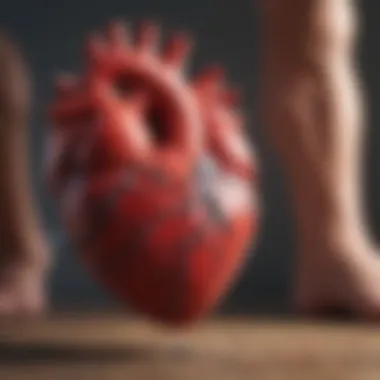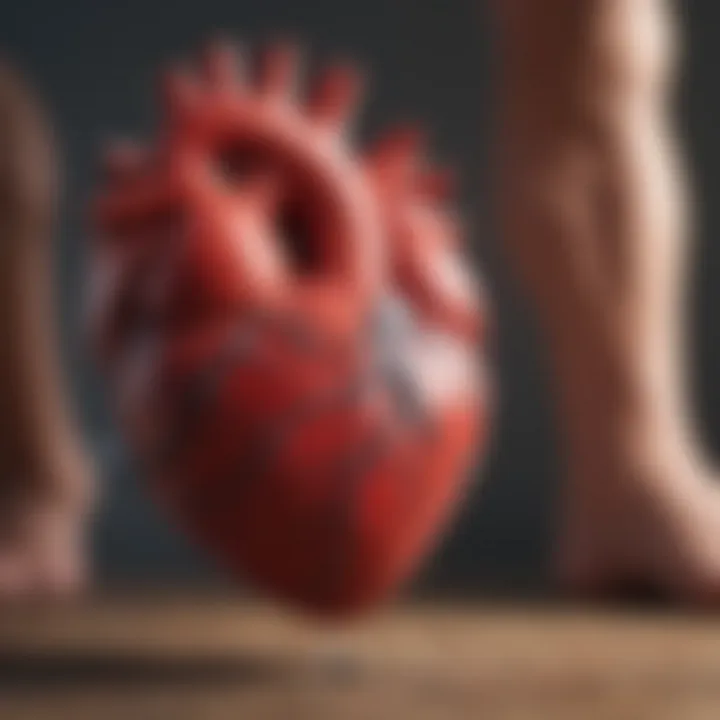Understanding the Heart: Its Structure and Function


Intro
The heart is often regarded as a symbol of life and emotion, but its true nature is far more intricate. When examining its anatomy and physiology, the heart reveals itself as a remarkable muscular organ vital for sustaining human existence. Understanding its structure and function is imperative, particularly in the context of health and disease. This article aims to provide an in-depth exploration of the heart's muscular composition, the distinctive characteristics of cardiac muscle, and its integral role in the circulatory system.
As we navigate through the various aspects of this topic, we will delve into essential terms and concepts that define cardiac physiology and its significance. While much has been studied about the heart, there remains a rich field of inquiry ripe for further examination.
In the subsequent sections, readers will find a detailed analysis grounded in scientific research, aimed at educators, students, researchers, and professionals. By dismantling the complexities surrounding cardiac function, we will illuminate its importance not only in physical health but within a broader scope of overall well-being.
Prelude to Cardiac Anatomy
Understanding cardiac anatomy is crucial for comprehending the intricate workings of the heart. This section introduces the heart as a central organ, emphasizes its structural components, and highlights how these aspects contribute to overall cardiovascular performance. An overview of the heart's anatomy not only informs about its physical structure but also prepares the reader to analyze its function and role in circulation, ultimately serving as a solid foundation for the entire article.
The Heart as a Central Organ
The heart is often regarded as the centerpiece of human physiology. Its role extends beyond mere blood pumping; it is a vital regulator of body systems. The heart ensures a continuous supply of oxygen-rich blood to tissues, maintaining homeostasis. It demonstrates remarkable adaptability in responding to changes in physical demands, exemplifying its significance in both health and disease.
Components of the Heart
Each component of the heart plays a specific role, working in harmony to facilitate efficient blood circulation. Understanding these elements is essential for appreciating how they function collectively.
Chambers of the Heart
The heart consists of four chambers: the right atrium, right ventricle, left atrium, and left ventricle. Each chamber has a distinct role in the cardiac cycle. The right atrium receives deoxygenated blood from the body, while the right ventricle pumps it to the lungs. Conversely, the left atrium receives oxygenated blood from the lungs, and the left ventricle distributes it to the rest of the body. This division of labor enables efficient blood flow pathways, making the chambers vital for proper circulation. Their unique feature of separation prevents mixing of oxygenated and deoxygenated blood, which is crucial for maximizing the efficiency of oxygen transport.
Valves and Their Function
Valves within the heart ensure unidirectional blood flow. The tricuspid valve, pulmonary valve, mitral valve, and aortic valve are instrumental in regulating this flow. Each valve opens and closes at appropriate times, allowing blood to move freely in one direction while preventing backflow. This mechanism is critical for maintaining effective circulation and pressure within the heart chambers, thus their design is tailored for durability under constant stress. Their unique design makes them resilient to wear, essential for long-term heart functionality.
Major Blood Vessels
Major blood vessels connected to the heart include the aorta, superior vena cava, inferior vena cava, pulmonary arteries, and pulmonary veins. These vessels form the intricate network through which blood travels to and from the heart. The aorta serves as the primary artery carrying oxygenated blood from the heart to the body, while the vena cavae return deoxygenated blood back to the heart. This structural network is vital for systemic and pulmonary circulation, demonstrating how integral these vessels are for heart function. Their robust structure allows for efficient transport and adaptation to varying pressure gradients within the circulatory system.
Understanding these components lays the groundwork for comprehending how cardiac muscle functions and interacts with the body.
Muscle Composition: Heart vs. Skeletal Muscle
Understanding the composition of cardiac muscle in comparison to skeletal muscle is crucial in grasping their different functions and roles in the body. Each muscle type has distinct structural features that cater to their specific physiological needs. Cardiac muscle, found in the heart, is specialized for continuous, rhythmic contractions. This ensures that blood circulates throughout the body efficiently. In contrast, skeletal muscle, attached to bones, is designed for voluntary movement and strength. The unique attributes of these muscle types allow them to excel in their respective roles, making them essential components of the human anatomy.
Types of Muscle Tissue
Cardiac Muscle
Cardiac muscle is involuntary and striated, characterized by its unique ability to contract continuously without fatigue. One key aspect of cardiac muscle is its self-exciting nature, meaning it can initiate contractions on its own without neural stimulation. This property is essential as it allows the heart to maintain a regular heartbeat. The interconnected nature of cardiac myocytes ensures coordinated contractions, which is vital for effective blood pumping. Importantly, these characteristics make cardiac muscle a focus in studies related to heart disease and overall cardiovascular health.
Skeletal Muscle
Skeletal muscle, the most prevalent type in the body, plays a significant role in voluntary movements. This muscle type is also striated, but unlike cardiac muscle, its contractions are controlled by the nervous system. Skeletal muscle fibers are organized into bundles, permitting coordinated movement. An important characteristic of skeletal muscle is its adaptability; it can increase in size and strength through exercise. This adaptability benefits overall fitness and physical performance. However, over-exertion can lead to injury, marking a disadvantage of skeletal muscle.
Smooth Muscle
Smooth muscle is non-striated and involuntary, found in the walls of internal organs like the intestines and blood vessels. Its contractions are slower and more sustained than those of cardiac or skeletal muscle. One significant characteristic of smooth muscle is its ability to contract without tiring quickly, which is advantageous for organs that need to maintain tension over long periods. This muscle type's unique features are crucial for bodily functions such as digestion and regulation of blood flow. However, smooth muscle's lack of rapid response could be seen as a limitation in specific contexts.
Histological Features of Cardiac Muscle
Myocytes
Myocytes are the fundamental units of cardiac muscle tissue. They are specialized cells that contract to pump blood. A defining feature of myocytes is their unique shape, which is shorter and branched, allowing them to interconnect at regions called intercalated discs. This connection ensures that action potentials, or electrical signals, spread quickly throughout the heart, leading to synchronized contractions. The structure and function of myocytes make them highly relevant for understanding cardiovascular physiology and heart diseases.
Intercalated Discs


Intercalated discs are specialized connections between cardiac myocytes that facilitate rapid communication and electrical coupling. This feature allows the heart to function as a single coordinated unit. An important characteristic of intercalated discs is the presence of gap junctions, which permit ions and electrical signals to pass swiftly between cells. This feature is beneficial for maintaining a consistent heart rhythm. Disruption in these connections can result in arrhythmias, emphasizing their crucial role in heart function.
Striations in Cardiac Muscle
Striations are visible bands in cardiac muscle that reflect its organized structure. These striations result from the arrangement of actin and myosin filaments within the myocytes. This ordered organization is key for the efficient contraction and relaxation of the heart. Striations also allow for the strength and resilience of cardiac muscle to withstand repetitive contractions. However, any alterations in this structural integrity can lead to impaired heart function, making its study vital in cardiovascular research.
Mechanics of Heart Function
The mechanics of heart function hold paramount importance in understanding how this vital organ operates within the circulatory system. This section delineates the key components involved in the heart's contraction and circulation roles. Recognizing these aspects can help inform both medical professionals and interested readers about the delicate balance that maintains cardiovascular health. It also sheds light on the underlying physiological processes that are critical for sustaining life.
Contraction Cycle
A pivotal aspect of heart function encompasses the contraction cycle, with two phases: systole and diastole. Both of these phases are integral to the heart's ability to pump blood effectively.
Systole and Diastole
Systole refers to the phase when the heart contracts, pumping blood out of the chambers. On the other hand, diastole is when the heart relaxes, allowing the chambers to fill with blood. This alternating pattern is key to maintaining a continuous blood flow within the body.
The primary characteristic of systole and diastole is their cyclical nature. This rhythmic action is essential as it ensures that tissues receive an adequate supply of oxygen and nutrients while removing waste products. This makes the blood circulation system efficient. In this article, distinguishing these phases provides clarity on how they contribute to heart health.
A unique feature is the time each phase takes during a heartbeat. For most individuals, the heart spends about two-thirds of its cycle in diastole and one-third in systole. This balance aids in proper blood flow, but imbalances could lead to issues like heart failure.
Role of Calcium Ions
Calcium ions play a crucial role in cardiac muscle contraction. When an electrical impulse triggers a heartbeat, calcium ions flow into the cardiac muscle cells, initiating the contraction process. This influx of calcium is vital for the function of myocytes, the heart's muscle cells.
The key characteristic of calcium ions in heart contractions is their ability to trigger muscle contraction. This makes them a crucial point of focus when examining heart function. The seamless flow of calcium ions maintains efficient heartbeats. In the context of this article, understanding the significance of calcium ions emphasizes their necessity in promoting cardiac health.
A unique feature concerning calcium ions is their role in the electrical conduction system of the heart. Disruptions in calcium signaling can lead to arrhythmias, indicating a potential disadvantage in managing heart health.
Electrical Conduction System
The electrical conduction system is the heart's internal network of specialized cells that coordinate heartbeats. This system allows the heart to contract in a synchronized manner, essential for optimal blood circulation.
A key characteristic of this system is the sinoatrial (SA) node, often referred to as the heart's natural pacemaker. It generates the electrical signals that initiate each heartbeat, making it a focal aspect of this article. Understanding the functionality of the electrical conduction system elucidates how heart rhythms are maintained.
A unique aspect of this system is its adaptability. It can respond to bodily demands such as stress or physical exertion. However, failure in this system, like dysfunction of the SA node, can result in serious health implications such as bradycardia or tachycardia.
Role of the Heart in Circulation
The heart serves as a pump for blood, playing a fundamental role in circulation. This is broken down into two primary paths: pulmonary circulation and systemic circulation.
Pulmonary Circulation
Pulmonary circulation describes the pathway where deoxygenated blood flows from the heart to the lungs and returns oxygenated back to the heart. The key characteristic of this route is its crucial role in oxygen exchange, vital for maintaining life. This makes it a significant area of discussion within this article.
A unique feature of pulmonary circulation is its specific focus on the lungs' function. It efficiently clears carbon dioxide while replenishing oxygen, showcasing its critical role within the overall cardiovascular system.
Systemic Circulation
Systemic circulation encompasses the delivery of oxygenated blood from the heart to the rest of the body. This pathway is essential as it nourishes tissues and organs with necessary elements for daily function.
The primary characteristic of systemic circulation is its extensive reach. It serves every part of the body, making it essential for sustaining life. This expansive reach highlights why it deserves attention within the context of understanding heart function.
A unique aspect of systemic circulation is its adaptability based on demand. The body can prioritize blood flow to specific areas, such as muscles during exercise, emphasizing the efficiency and adaptability of the system.
Heart Rate Regulation
Heart rate regulation refers to how the body maintains an appropriate pace of heartbeats. This is pivotal for ensuring that oxygen supply meets bodily needs.


A key characteristic of heart rate regulation is the involvement of both intrinsic and extrinsic factors. Internal signals from the nervous system and hormones adjust heart rates according to activity levels. This adaptability is significant in a discussion about heart mechanics.
The unique feature here is how various factors such as exercise, stress, and health conditions can influence heart rate. For instance, in a healthy adult at rest, the heart rate averages around 60 to 100 beats per minute, but this can vary significantly based on physical demands. This flexibility showcases the importance of heart rate regulation in maintaining optimal heart function.
Health Implications of Cardiac Muscle Function
The health implications of cardiac muscle function are significant, as they directly affect an individual’s overall well-being. The heart’s ability to function efficiently determines not only the supply of oxygen to various organs but also reflects on muscular and metabolic health. Understanding how cardiac muscle operates provides insight into conditions that can arise from its dysfunction.
Monitoring heart health is crucial. Regular assessments enable early detection of disease, allowing for timely intervention and improved outcomes.
Common Cardiovascular Diseases
Coronary Artery Disease
Coronary artery disease, often characterized by the buildup of plaque in the coronary arteries, limits blood flow to the heart muscle. This condition is notable because it is one of the leading causes of heart attacks. Individuals with coronary artery disease may experience chest pain or discomfort, a signal that the heart is not receiving adequate oxygen.
- One key characteristic of coronary artery disease is its preventability. Many lifestyle changes, such as improving diet and increasing physical activity, can reduce the risk.
- This aspect makes it a popular focus in studies relating heart health with lifestyle, emphasizing behaviors that contribute to heart disease.
- A unique feature of this condition is the role of inflammation in plaque formation. Chronic inflammation can lead to plaque rupture, escalating the risk of severe cardiac events.
Heart Failure
Heart failure occurs when the heart cannot pump blood efficiently. It may develop as a consequence of coronary artery disease or other conditions affecting the heart's ability to contract. One of the key characteristics of heart failure is that it can be chronic and progressive. Symptoms may include shortness of breath and fatigue.
- This makes heart failure a significant point of discussion in cardiology. Patients often need long-term management and lifestyle adjustments to cope with their condition.
- A compelling aspect of heart failure is its multifaceted nature, requiring a comprehensive approach to treatment, including medication and lifestyle modification.
Arrhythmias
Arrhythmias represent irregular heartbeats that may disrupt the heart's ability to pump blood effectively. These can range from harmless to life-threatening. A key characteristic of arrhythmias is their variety, with different types requiring specific treatments.
- Arrhythmias are beneficial for this article because they show the heart's complexity and the importance of proper function.
- The unique feature of arrhythmias is their potential reversibility through lifestyle changes or interventions. Understanding the causes of these irregularities can empower individuals to take charge of their heart health.
Preventive Measures and Lifestyle Choices
Exercise and Physical Activity
Exercise and physical activity are vital components for maintaining heart health. Regular physical activity strengthens the heart muscle, improving its efficiency and reducing the risk of cardiovascular diseases. A key characteristic of exercise is its preventive capacity against conditions like hypertension and obesity.
- This factor makes it a prominent focus in heart health discussions. The unique feature of physical activity is its ability to influence mood and stress levels, further benefiting heart health overall.
Diet and Nutrition
Diet and nutrition play a foundational role in cardiac health. A well-balanced diet rich in fruits, vegetables, whole grains, and lean proteins supports the heart. A key characteristic is that good nutrition can help control weight, cholesterol levels, and blood pressure.
- This study of diet highlights the connection between what we eat and heart disease prevention. The unique aspect of this is the long-term benefits of adopting healthier eating patterns, potentially leading to improved lifespan and quality of life.
Stress Management
Stress management techniques are essential for cardiovascular health. Chronic stress can contribute to high blood pressure and inflammation, both risk factors for heart disease. The critical aspect of stress management is its impact on overall heart function.
- This factor adds another layer to understanding heart health. Mindfulness practices, and other stress-reducing techniques contribute to lower stress levels and improved cardiovascular function.
- The unique feature of stress management is its complementary nature to other health practices, creating a holistic approach to preventing heart issues.
Cardiac Muscle and Aging
Aging has a profound effect on cardiac muscle, which is critical for its function and health. As individuals age, the heart undergoes significant changes that can impact its performance and overall well-being. This section discusses the implications of these age-related changes and highlights the importance of understanding how they affect the heart.
Age-Related Changes in Cardiac Muscle
Hypertrophy of the Heart Muscle
Hypertrophy, or the thickening of cardiac muscle, occurs as the heart adapts to increased workload. This can be due to conditions such as hypertension or heart valve diseases. Hypertrophy is characterized by an increase in muscle mass, which can initially improve cardiac output. However, over time, this adaptation may lead to complications. In this article, we examine how hypertrophy can be a response to the body’s demands, presenting both advantages and disadvantages. While it may help in the short term, prolonged hypertrophy can cause the heart to become less efficient.


Decreased Elasticity
As people age, cardiac muscle may lose its elasticity. This loss impacts the heart's ability to fill and contract effectively. Reduced elasticity means that the heart may struggle to pump blood efficiently, leading to a decrease in overall cardiovascular health. In this article, we emphasize the significance of decreased elasticity as a common phenomenon in aging. It is essential to understand that while aging is natural, decreased elasticity can have serious consequences for heart function, making it a vital factor to monitor.
Impact on Cardiac Output
The changes in cardiac muscle, including hypertrophy and decreased elasticity, ultimately affect cardiac output. Cardiac output is the amount of blood the heart pumps in a minute, crucial for ensuring that organs receive adequate blood supply. Aging can lead to diminished cardiac output, which can contribute to symptoms such as fatigue and decreased exercise tolerance. This article underscores the importance of monitoring cardiac output as people grow older.
Maintaining Heart Health in Older Adults
Aging does not have to result in poor heart health. There are proactive measures that can help maintain the integrity of cardiac muscle and functionality as one ages. Understanding the factors that influence heart health is key for older adults.
Regular Health Check-Ups
Regular health check-ups are essential for monitoring heart health. These visits enable healthcare professionals to assess risk factors such as hypertension and cholesterol levels. By keeping abreast of these factors, individuals can take steps to manage them effectively. In this context, regular health check-ups stand out as a fundamental practice in maintaining heart health. They provide an opportunity for early intervention if any issues arise, allowing for timely management.
Medication Management
Medication management is critical for older adults dealing with heart conditions. With increasing age, many individuals may require medications to manage chronic conditions. Proper medication management can have a significant impact on heart health, helping to control blood pressure, cholesterol, and other conditions that affect cardiac muscle. The need for accurate and effective medication regimens makes this aspect a focal point in the consideration of heart health in aging populations.
Importance of Social Connections
Research indicates that maintaining social connections can enhance heart health. Social interactions may reduce stress and promote a sense of belonging, both of which have a positive impact on overall health. In this article, we reinforce the role of social connections as an often-overlooked factor in heart health. By nurturing relationships, individuals can support not only their emotional well-being but also their cardiovascular health.
Maintaining social ties is vital. They provide support and promote healthier lifestyles which are crucial for heart health.
This section highlights the interconnectedness of cardiac muscle aging and the practices that can help maintain heart health. By understanding these dynamics, individuals can take proactive measures to promote their cardiovascular health as they age.
End: The Heart as a Muscle in Health and Disease
The conclusion of this article reiterates the significance of comprehending the heart's muscular structure and function. The heart is not merely a pump; it is a complex organ critical to maintaining life. Understanding its anatomy and physiology is essential for recognizing how it supports overall health.
As we have explored throughout the article, cardiac muscle exhibits unique properties. Its ability to contract rhythmically and continuously plays a vital role in circulation. This distinction separates it from other muscle types, making it a fascinating subject in both health and disease. The implications of its functionality underscore the necessity of maintaining cardiac health to prevent diseases that can arise due to its deterioration.
Revisiting the Centrality of Cardiac Muscle
Cardiac muscle, or myocardium, is fundamental to an individual's well-being. It is responsible for the heart's pumping action, which facilitates blood circulation. Effective circulation delivers oxygen and nutrients to tissues while also removing waste products.
Moreover, cardiac muscle has intrinsic properties that enable it to function autonomously. This means it can continue to contract without external signals. Understanding this centrality emphasizes the heart's role as a muscle that must be cared for throughout life. Insufficient attention can lead to various heart conditions.
Future Directions for Research
Research into heart health continues to advance. Future studies are likely to focus on innovative ways to enhance cardiac function and repair damage.
Cardiac Regenerative Medicine
This field investigates the potential of regenerating heart tissue. Researchers explore various methods to replace damaged muscle or even create new muscle cells from stem cells. The unique aspect of cardiac regenerative medicine lies in its ability to promote recovery after heart attacks. This approach shows promise as it may one day minimize the need for transplants.
However, challenges exist. It is important to ensure that new cells integrate properly into existing heart structures.
Biomaterials and Heart Repair
Biomaterials used in cardiac applications facilitate healing. These materials are engineered to work with living tissues and can support heart repair. Their key characteristic is biocompatibility, allowing them to function alongside human cells without adverse effects.
The advantage of using biomaterials is their potential to improve outcomes in patients with heart failure or those undergoing surgical procedures. Nevertheless, the effectiveness can vary based on the biomaterial's properties.
Advanced Imaging Techniques
With the evolução of technology, advanced imaging techniques are revolutionizing how we see the heart. Imaging provides critical insights into heart structure and function. Techniques such as MRI and CT scans allow for detailed visualization of cardiac muscle.
The key characteristic of these imaging methods is their ability to capture real-time function while assessing heart health. However, there are limitations, including cost and technical expertise required.
In summary, understanding the heart as a muscle, both in health and in various diseases, leads to better management strategies and innovative treatments. By embracing research developments and insights into cardiac physiology, individuals can aspire to enhance their cardiac health and overall quality of life.
"The heart's complexity mirrors the intricate balance of many systems in the body. It requires not only study but also dedicated care to ensure its longevity and health."







